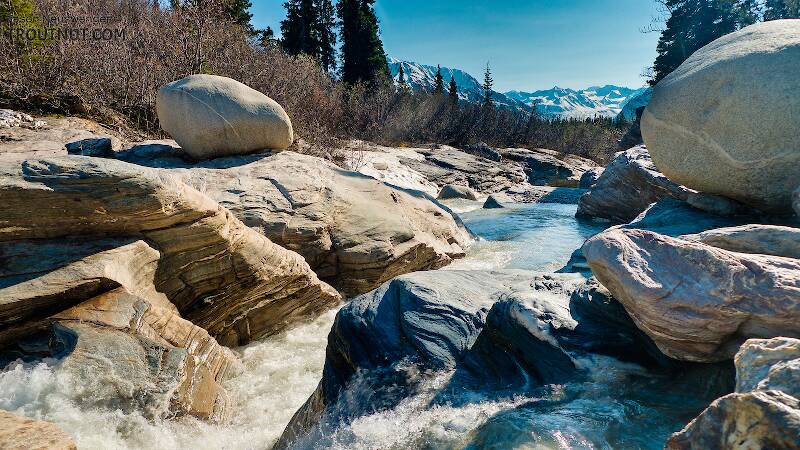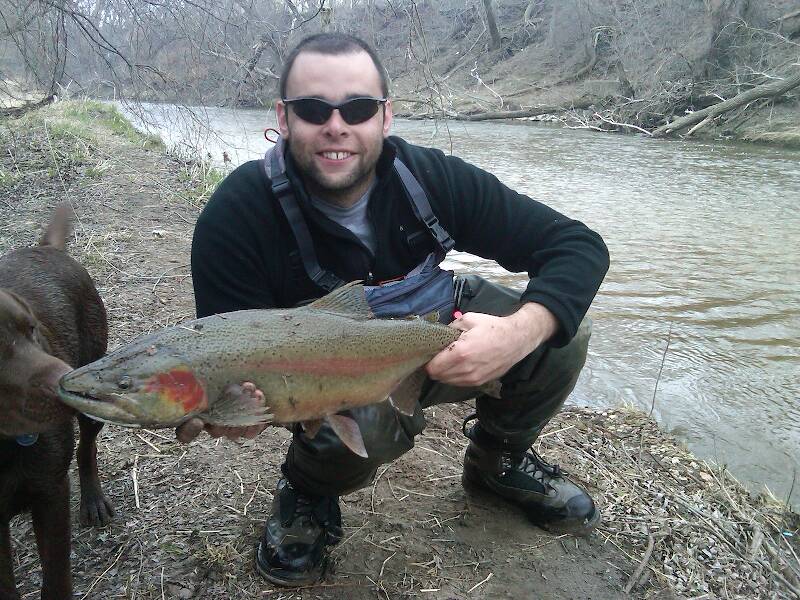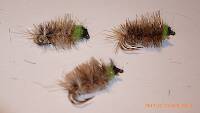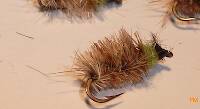
Blue-winged Olives
Baetis
Tiny Baetis mayflies are perhaps the most commonly encountered and imitated by anglers on all American trout streams due to their great abundance, widespread distribution, and trout-friendly emergence habits.
Featured on the forum

This specimen keys pretty easily to Onocosmoecus, and it closely resembles a specimen from Alaska which caddis expert Dave Ruiter recognized as this genus. As with that specimen, the only species in the genus documented in this area is Onocosmoecus unicolor, but Dave suggested for that specimen that there might be multiple not-yet-distinguished species under the unicolor umbrella and it would be best to stick with the genus-level ID. I'm doing the same for this one.

Troutnut is a project started in 2003 by salmonid ecologist Jason "Troutnut" Neuswanger to help anglers and
fly tyers unabashedly embrace the entomological side of the sport. Learn more about Troutnut or
support the project for an enhanced experience here.
PaulRoberts on May 12, 2014May 12th, 2014, 6:16 pm EDT
The following is an excerpt from a write up of a day's fishing on a steep, rugged, canyon stream that contains small trout. Such fishing ends up being a whole lot of work for rewards only a starving artist, philosopher or subsistence fisherman could appreciate. But it highlights what actually can be required to catch trout on fly tackle.
Then imagine how many fish we pass, spook, or put off as we fish blind? Fly fishing is a pretty exacting game, and it's immensely instructive to try and catch an individual fish you can see. You are not relying on the fish to find your fly, you must take it to them: Understand water, identify potential feeding lanes, get your fly there, guide it through correctly, and detect the take. Each lane is a challenge.
...
Fast turbulent water is the toughest to deal with, pretty much requiring a very close approach, and deliberate presentation. The water is granite clear so one must learn to slither like a snake to get that close. These streams are bedded by fractured mountains and strewn with boulders from bowling ball to car to house sized –the water, and the angler, simply forced to go around. It’s physically exhausting fishing, both from simply negotiating the topography and giant substrate, and from the sheer concentration deliberate presentation to short tight lanes demands.
...
I came upon a short flat stretch that provided some welcome relief from the ruggedness, and a long flat run -as classic a “dry fly pool” as one could hope for in such topography. And it was high time for a rest break.

I climbed the canyon wall and perched myself on an outcrop well above the pool to observe, and eat my lunch. Soon I began to spy trout in the long shallow run: “One, two, three,... four... Oh! and there’s a good one.” It held nearest the tailout, ahead of a “cushion” rock and it fed subsurface; Its gold-green side glinting every now and again. It looked to go … 14”? “Whoa.” I thought to myself. That would be quite a bug-eater for this stream. But my estimate, I knew, would be influenced by the depth it held in, and that was tough to judge from up high. Refraction has a tendency to shrink the image of a fish the deeper it is holding. Was his hold 1-1/2ft or 2-1/2ft deep? I marked his lie –just beyond the tip of an overhanging branch of one of the young cottonwoods lining the run on the opposite bank– and planned my approach.
I had to hike well down below the run so that the fish wouldn’t see me descending the steep bank. When I reached the run I moved patiently up, careful not to crunch cobbles, to the accelerating lip, stopping behind a midstream cobble -the closest I could get to the fish without pushing a wake. I was nicely positioned, quartering from below, and I studied the current around his lie. (I've put labels on the image of the pool above -though they're easy to miss.)
I could no longer see the trout of course, nor did the surface current reveal his cushion, at first. Despite the relatively calm flow, there were two current tongues, with a long but slight eddy between, discernable in the speed of the surface bubbles and by the substrate color. The eddy had collected darker sediment and was bordered on each side by paler cleaner golden-brown diatom-covered substrate swept clean by the current tongues. It was likely that the cobble the fish held against had created that eddy.
On my cast, I would have to lay my leader and line on the nearside tongue. If any of the line got into the eddy currents, drag would develop in the tippet. I readjusted my position slightly right to widen my angle on the right side tongue.
Satisfied with what I had to do, I readied my terminal rig. I often do this at the moment of truth because it calms me down and lets the fish relax in case my approach caused any disturbance. I still could not ascertain the exact depth of the hold, due to reflection. He was at least 12” I was sure, likely better; Still, a “good one”. I turned my attention to my preparations, and took a deep breath. I might as well have been presenting to a 20-incher on the Miracle Mile.
I knotted on a #16 Parachute Baetis, as some had been coming off earlier, and since he hadn’t risen to the surface I added a #18 unweighted Baetis nymph on a short dropper. The dropper nymph required that my cast unroll straight -no hooks or fades- and best if the nymph landed first (easier with some weight on the dropper) for the nymph to sink and the dropper line come under some tension against the dry fly. Otherwise the fish could sample the fake nymph without my knowing it. With the relatively flat water I wouldn’t get more than a few shots, if that, before the casts triggered his alarm system and put him down or sent him scurrying for cover.
I put line in the air and made a measuring cast just short and to one side, and found that I could not see my fly due to the sheet of silver reflections from the low sun. “Glad I checked,” I breathed. I added a small daub of fluorescent putty to the tippet knot and made my pitch to the fish. The fly landed …somewhere out there, in a field of silver. I couldn’t see my fly or my indicator. I cast again, ducked low trying to make a silhouette out but to no avail. I cast right and spotted my putty indicator, then cast to the fish again, and could not see it! Had he sampled my fly?! Could the game already be over? Repeated casts to find out would surely put him down. Do I switch flies, just to be sure? I’d better do it, I decided.
I snatched my leader, switched to a #16 indicator dry with a dark red fluorescent post and a different Baetid nymph. This dry I could see on the water. And he did not come. The tailout was lifeless.
Two days later I was back on the stream with a plan to fish pocket water under the bright sun until the afternoon thunderheads developed, then check on my “good one” in the “flat run”. The day progressed like clockwork and, under a darkening sky, Baetis duns began to appear. Soon I was perched above the flat run, watching my “good one” holding against his cushion. As I watched, he flashed his gold-green side taking something subsurface, and then he came up in a full rolling rise, his pointed snout piercing the surface. “OK … 13 inches”, I muttered. “That’ll do.”
From my position at the tailout, the higher sun and darker sky made the surface less reflective but, just in case, I chose a #16 Baetis parachute with a tall dark slate-gray post, sans dropper nymph -two complications out of the way. As I patiently rigged, a spatting rise came to my right in a current tongue behind a large boulder. I covered him first, in a narrow tongue coming off the boulder’s flank, and he took the parachute on the third drift. Pumping him revealed his last rise –a Baetis dun.

I covered my “good one” and on the first drift down the right current tongue he came in an exuberant, splashy rise. I paused, lifted, and he was on. Right away I could see he was not going to hit 14”, or 13”. His lie turned out to be about 18” deep, and he taped a mere 11-3/4”, and worth every moment.

Then imagine how many fish we pass, spook, or put off as we fish blind? Fly fishing is a pretty exacting game, and it's immensely instructive to try and catch an individual fish you can see. You are not relying on the fish to find your fly, you must take it to them: Understand water, identify potential feeding lanes, get your fly there, guide it through correctly, and detect the take. Each lane is a challenge.
...
Fast turbulent water is the toughest to deal with, pretty much requiring a very close approach, and deliberate presentation. The water is granite clear so one must learn to slither like a snake to get that close. These streams are bedded by fractured mountains and strewn with boulders from bowling ball to car to house sized –the water, and the angler, simply forced to go around. It’s physically exhausting fishing, both from simply negotiating the topography and giant substrate, and from the sheer concentration deliberate presentation to short tight lanes demands.
...
I came upon a short flat stretch that provided some welcome relief from the ruggedness, and a long flat run -as classic a “dry fly pool” as one could hope for in such topography. And it was high time for a rest break.

I climbed the canyon wall and perched myself on an outcrop well above the pool to observe, and eat my lunch. Soon I began to spy trout in the long shallow run: “One, two, three,... four... Oh! and there’s a good one.” It held nearest the tailout, ahead of a “cushion” rock and it fed subsurface; Its gold-green side glinting every now and again. It looked to go … 14”? “Whoa.” I thought to myself. That would be quite a bug-eater for this stream. But my estimate, I knew, would be influenced by the depth it held in, and that was tough to judge from up high. Refraction has a tendency to shrink the image of a fish the deeper it is holding. Was his hold 1-1/2ft or 2-1/2ft deep? I marked his lie –just beyond the tip of an overhanging branch of one of the young cottonwoods lining the run on the opposite bank– and planned my approach.
I had to hike well down below the run so that the fish wouldn’t see me descending the steep bank. When I reached the run I moved patiently up, careful not to crunch cobbles, to the accelerating lip, stopping behind a midstream cobble -the closest I could get to the fish without pushing a wake. I was nicely positioned, quartering from below, and I studied the current around his lie. (I've put labels on the image of the pool above -though they're easy to miss.)
I could no longer see the trout of course, nor did the surface current reveal his cushion, at first. Despite the relatively calm flow, there were two current tongues, with a long but slight eddy between, discernable in the speed of the surface bubbles and by the substrate color. The eddy had collected darker sediment and was bordered on each side by paler cleaner golden-brown diatom-covered substrate swept clean by the current tongues. It was likely that the cobble the fish held against had created that eddy.
On my cast, I would have to lay my leader and line on the nearside tongue. If any of the line got into the eddy currents, drag would develop in the tippet. I readjusted my position slightly right to widen my angle on the right side tongue.
Satisfied with what I had to do, I readied my terminal rig. I often do this at the moment of truth because it calms me down and lets the fish relax in case my approach caused any disturbance. I still could not ascertain the exact depth of the hold, due to reflection. He was at least 12” I was sure, likely better; Still, a “good one”. I turned my attention to my preparations, and took a deep breath. I might as well have been presenting to a 20-incher on the Miracle Mile.
I knotted on a #16 Parachute Baetis, as some had been coming off earlier, and since he hadn’t risen to the surface I added a #18 unweighted Baetis nymph on a short dropper. The dropper nymph required that my cast unroll straight -no hooks or fades- and best if the nymph landed first (easier with some weight on the dropper) for the nymph to sink and the dropper line come under some tension against the dry fly. Otherwise the fish could sample the fake nymph without my knowing it. With the relatively flat water I wouldn’t get more than a few shots, if that, before the casts triggered his alarm system and put him down or sent him scurrying for cover.
I put line in the air and made a measuring cast just short and to one side, and found that I could not see my fly due to the sheet of silver reflections from the low sun. “Glad I checked,” I breathed. I added a small daub of fluorescent putty to the tippet knot and made my pitch to the fish. The fly landed …somewhere out there, in a field of silver. I couldn’t see my fly or my indicator. I cast again, ducked low trying to make a silhouette out but to no avail. I cast right and spotted my putty indicator, then cast to the fish again, and could not see it! Had he sampled my fly?! Could the game already be over? Repeated casts to find out would surely put him down. Do I switch flies, just to be sure? I’d better do it, I decided.
I snatched my leader, switched to a #16 indicator dry with a dark red fluorescent post and a different Baetid nymph. This dry I could see on the water. And he did not come. The tailout was lifeless.
Two days later I was back on the stream with a plan to fish pocket water under the bright sun until the afternoon thunderheads developed, then check on my “good one” in the “flat run”. The day progressed like clockwork and, under a darkening sky, Baetis duns began to appear. Soon I was perched above the flat run, watching my “good one” holding against his cushion. As I watched, he flashed his gold-green side taking something subsurface, and then he came up in a full rolling rise, his pointed snout piercing the surface. “OK … 13 inches”, I muttered. “That’ll do.”
From my position at the tailout, the higher sun and darker sky made the surface less reflective but, just in case, I chose a #16 Baetis parachute with a tall dark slate-gray post, sans dropper nymph -two complications out of the way. As I patiently rigged, a spatting rise came to my right in a current tongue behind a large boulder. I covered him first, in a narrow tongue coming off the boulder’s flank, and he took the parachute on the third drift. Pumping him revealed his last rise –a Baetis dun.

I covered my “good one” and on the first drift down the right current tongue he came in an exuberant, splashy rise. I paused, lifted, and he was on. Right away I could see he was not going to hit 14”, or 13”. His lie turned out to be about 18” deep, and he taped a mere 11-3/4”, and worth every moment.

Kschaefer3 on May 13, 2014May 13th, 2014, 5:56 am EDT
This is a great story! Thanks for sharing, Paul.
Crepuscular on May 13, 2014May 13th, 2014, 6:41 am EDT
nice
Martinlf on May 14, 2014May 14th, 2014, 7:53 pm EDT
Yes, now that's a story. Thank you, Paul.
"He spread them a yard and a half. 'And every one that got away is this big.'"
--Fred Chappell
--Fred Chappell
Crepuscular on May 15, 2014May 15th, 2014, 7:32 am EDT
Paul, that looks like T&T LPS.
PaulRoberts on May 16, 2014May 16th, 2014, 4:06 pm EDT
Paul, that looks like T&T LPS.
Yes! I remember you have one, or more, too. Mines rated for #2, but it handles a 4 with authority. I've taken stream browns with it up to 23". (I felt compelled to say that since Louis went and told us just how big his dry fly brown was! :)
Quick Reply
Related Discussions
Topic
Replies
Last Reply
1
Mar 9, 2012
by Wiflyfisher
by Wiflyfisher
1
Nov 18, 2007
by Martinlf
by Martinlf







